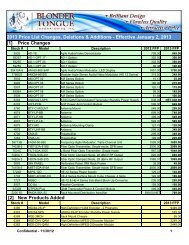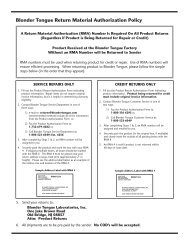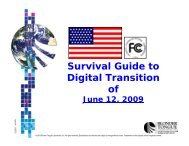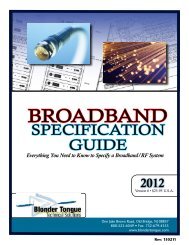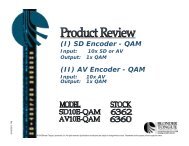Functional Block Diagram - Blonder Tongue Laboratories Inc.
Functional Block Diagram - Blonder Tongue Laboratories Inc.
Functional Block Diagram - Blonder Tongue Laboratories Inc.
You also want an ePaper? Increase the reach of your titles
YUMPU automatically turns print PDFs into web optimized ePapers that Google loves.
Broadband Specification Guide<br />
CATV Terms & Definitions<br />
Infrared<br />
Electromagnetic radiation with wavelength between 0.7 micrometer<br />
and about I millimeter. Wavelengths at the shorter end of this range<br />
are frequently called "near" infrared, and those longer than about 20<br />
micrometers, "far" infrared.<br />
Intrinsic Noise (See Noise, intrinsic)<br />
Isolation<br />
Electrical separation (or loss) between two locations or pieces of<br />
equipment. Degree of isolation usually specified in dB.<br />
Jacket<br />
A layer of material, generally plastic, that surrounds an optical fiber<br />
to protect it from physical damage. Unlike the cladding, the jacket is<br />
physically distinct from the fiber core.<br />
Joule<br />
An international unit of work or energy. The work required to maintain a<br />
current of one ampere through one ohm for one second. A Watt-second.<br />
Kilo<br />
A prefix for one thousand (1,000 or 101).<br />
Kilobit<br />
One thousand bits.<br />
Kilocycle (Kc)<br />
See Kilohertz.<br />
Kilohertz (kHz)<br />
1. One thousand hertz.<br />
2. One thousand cycles per second.<br />
Ku Band<br />
Range of frequencies used in satellite transmissions. Common uplink<br />
frequency for U.S. domestic satellites is 14 to 14.5 GHz with a downlink<br />
frequency of 11.7 to 12.2 GHz.<br />
Laser<br />
Acronym for "light amplification by stimulated emission of radiation."<br />
A device which generates or amplifies electromagnetic oscillations at<br />
wavelengths between the far infrared (sub-millimeter) and ultraviolet.<br />
Like any electromagnetic oscillator, a laser oscillator consists of two basic<br />
elements: an amplifying (active) medium and a regeneration or feedback<br />
device (resonant cavity). A laser's amplifying medium can be a gas,<br />
semiconductor, dye solution, etc. Feedback is typically from two mirrors.<br />
Distinctive properties of the electromagnetic oscillations produced<br />
include monochromaticity, high intensity, small beam divergence, and<br />
phase coherence. As a description of a device, "laser" refers to the active<br />
medium plus all equipment necessary to produce the effect called lasing.<br />
Lashed Cable<br />
An aerial cable fastened to its supporting messenger by a continuous<br />
spirally wrapped steel wire.<br />
Light Emitting Diode (LED)<br />
Acronym for light emitting diode.<br />
Lightguide<br />
Synonym for optical waveguide.<br />
Light Source<br />
A generic term that includes lasers and LED's.<br />
Lightwave<br />
Any electromagnetic radiation having a wavelength in the Range from<br />
800 to 1,600 nanometers in the near infrared region.<br />
Linear<br />
The characteristic of a device or network whose output signal voltage is<br />
directly proportional to its input signal voltage.<br />
Line Extender<br />
An unsophisticated amplifier operating at relatively high transmission<br />
levels in the feeder sub-system of a trunk plus feeder designed<br />
CATV system.<br />
LNA<br />
Low Noise Amplifier. Provides initial amplification of downlink signal at<br />
antenna location.<br />
LNB<br />
Low Noise <strong>Block</strong> (converter). Integrated LNA and down converter.<br />
Available in either C or Ku band inputs. The most prevalent output<br />
frequency scheme is 950-1450 MHz, however other schemes that have<br />
been used include 900-1400, 1000-1500 and 270-770 MHz.<br />
Local Origination<br />
Channels that are generated on site, such as those that are derived from<br />
character generators, laser disks, or VCR’s in the headend.<br />
Long Wavelength<br />
As applied to fiber optic systems, this term generally refers to operation<br />
at wavelengths in the range of 1,100 nanometers to 1,700 nanometers.<br />
Look Angle<br />
TVRO term that refers to both the azimuth and elevation angles required<br />
to sight or aim a dish to a given satellite.<br />
Loss<br />
Reduction in signal strength usually expressed in dB. Synonymous<br />
with attenuation.<br />
Low Band<br />
The radio spectrum between 54 and 88 MHz. Standard VHF television<br />
channels 2 through 6 fall within this spectrum.<br />
88



